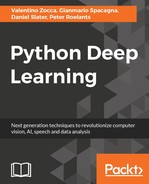"Machine Learning (CS229) is the most popular course at Stanford" –this is how a Forbes article by Laura Hamilton started, continuing- "Why? Because, increasingly, machine learning is eating the world".
Machine learning techniques are, indeed, being applied in a variety of fields, and data scientists are being sought after in many different industries. With machine learning, we identify the processes through which we gain knowledge that is not readily apparent from data, in order to be able to make decisions. Applications of machine learning techniques may vary greatly and are applicable in disciplines as diverse as medicine, finance, and advertising.
In this chapter, we will present different Machine learning approaches and techniques, and some of their applications to real-world problems, and we will introduce one of the major open source packages available in Python for machine learning, scikit-learn. This will lay the background for later chapters in which we will focus on a particular type of machine learning approach using neural networks that aims at emulating brain functionality, and in particular deep learning. Deep learning makes use of more advanced neural networks than those used during the 80's, thanks not only to recent developments in the theory but also to advances in computer speed and the use of GPUs (Graphical
Processing Units) versus the more traditional use of CPUs (Computing Processing Units). This chapter is meant mostly as a summary of what machine learning is and can do, and to prepare the reader to better understand how deep learning differentiates itself from popular traditional machine learning techniques.
In particular, in this chapter we will cover:
- What is machine learning?
- Different machine learning approaches
- Steps involved in machine learning systems
- Brief description of popular techniques/algorithms
- Applications in real-life
- A popular open source package
Machine learning is often mentioned together with terms such as "big data" and "artificial intelligence", or A.I. for short, but it is quite different from both. In order to understand what machine learning is and why it is useful, it is important to understand what big data is and how machine learning applies to it. Big data is a term used to describe huge data sets that are created as the result of large increases in data gathered and stored, for example, through cameras, sensors, or Internet social sites. It is estimated that Google alone processes over 20 petabytes of information per day and this number is only going to increase. IBM estimated (http://www-01.ibm.com/software/data/bigdata/what-is-big-data.html) that every day, 2.5 quintillion bytes are created and that 90% of all the data in the world has been created in the last two years.
Clearly, humans alone are unable to grasp, let alone analyze, such a huge amount of data, and machine learning techniques are used to make sense of these very large data sets. Machine learning is the tool used for large-scale data processing and is well suited for complex datasets with huge numbers of variables and features. One of the strengths of many machine learning techniques, and deep learning in particular, is that it performs best when it can be used on large data sets improving its analytic and predictive power. In other words, machine learning techniques, and especially deep learning neural networks, "learn" best when they can access large data sets in order to discover patterns and regularities hidden in the data.
On the other hand, machine learning's predictive ability can be well adapted to artificial intelligence systems. Machine learning can be thought of as "the brain" of an artificial intelligence system. Artificial intelligence can be defined (though this definition may not be unique) as a system that can interact with its environment: artificial intelligence machines are endowed with sensors that allow them to know about the environment they are in and tools with which they can relate back. Machine learning is therefore the brain that allows the machine to analyze the data ingested through its sensors to formulate an appropriate answer. A simple example is Siri on an iPhone. Siri hears the command through its microphone and outputs an answer through its speakers or through its display, but in order to do so it needs to "understand" what it is being said to formulate the correct answer. Similarly, driverless cars will be equipped with cameras, GPS systems, sonars and lidars, but all this information needs to be processed in order to provide a correct answer, that is, whether to accelerate, brake, turn, and so on. The information processing that leads to the answer represents what machine learning is.
